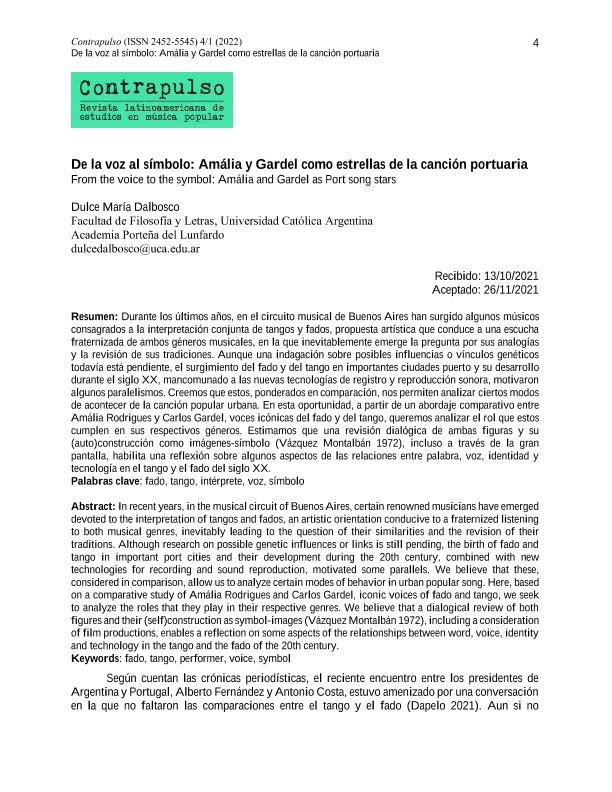Artículo
Durante los últimos años, en el circuito musical de Buenos Aires han surgido algunos músicos consagrados a la interpretación conjunta de tangos y fados, propuesta artística que conduce a una escucha fraternizada de ambos géneros musicales, en la que inevitablemente emerge la pregunta por sus analogías y la revisión de sus tradiciones. Aunque una indagación sobre posibles influencias o vínculos genéticos todavía está pendiente, el surgimiento del fado y del tango en importantes ciudades puerto y su desarrollo durante el siglo XX, mancomunado a las nuevas tecnologías de registro y reproducción sonora, motivaron algunos paralelismos. Creemos que estos, ponderados en comparación, nos permiten analizar ciertos modos de acontecer de la canción popular urbana. En esta oportunidad, a partir de un abordaje comparativo entre Amália Rodrigues y Carlos Gardel, voces icónicas del fado y del tango, queremos analizar el rol que estos cumplen en sus respectivos géneros. Estimamos que una revisión dialógica de ambas figuras y su (auto)construcción como imágenes-símbolo (Vázquez Montalbán 1972), incluso a través de la gran pantalla, habilita una reflexión sobre algunos aspectos de las relaciones entre palabra, voz, identidad y tecnología en el tango y el fado del siglo XX. In recent years, in the musical circuit of Buenos Aires, certain renowned musicians have emerged devoted to the interpretation of tangos and fados, an artistic orientation conducive to a fraternized listening to both musical genres, inevitably leading to the question of their similarities and the revision of their traditions. Although research on possible genetic influences or links is still pending, the birth of fado and tango in important port cities and their development during the 20th century, combined with new technologies for recording and sound reproduction, motivated some parallels. We believe that these, considered in comparison, allow us to analyze certain modes of behavior in urban popular song. Here, based on a comparative study of Amália Rodrigues and Carlos Gardel, iconic voices of fado and tango, we seek to analyze the roles that they play in their respective genres. We believe that a dialogical review of both figures and their (self)construction as symbol-images (Vázquez Montalbán 1972), including a consideration of film productions, enables a reflection on some aspects of the relationships between word, voice, identity and technology in the tango and the fado of the 20th century.
De la voz al símbolo: Amália y Gardel como estrellas de la canción portuaria
Título:
From the voice to the symbol: Amália and Gardel as Port song stars
Fecha de publicación:
01/2022
Editorial:
Universidad Alberto Hurtado
Revista:
Contrapulso
e-ISSN:
2452-5545
Idioma:
Español
Tipo de recurso:
Artículo publicado
Clasificación temática:
Resumen
Palabras clave:
FADO
,
TANGO
,
INTÉRPRETE
,
VOZ
,
SÍMBOLO
Archivos asociados
Licencia
Identificadores
Colecciones
Articulos(SEDE CENTRAL)
Articulos de SEDE CENTRAL
Articulos de SEDE CENTRAL
Citación
Dalbosco, Dulce María; De la voz al símbolo: Amália y Gardel como estrellas de la canción portuaria; Universidad Alberto Hurtado; Contrapulso; 4; 1; 1-2022; 4-18
Compartir
Altmétricas




